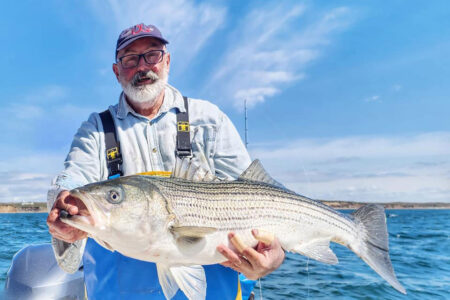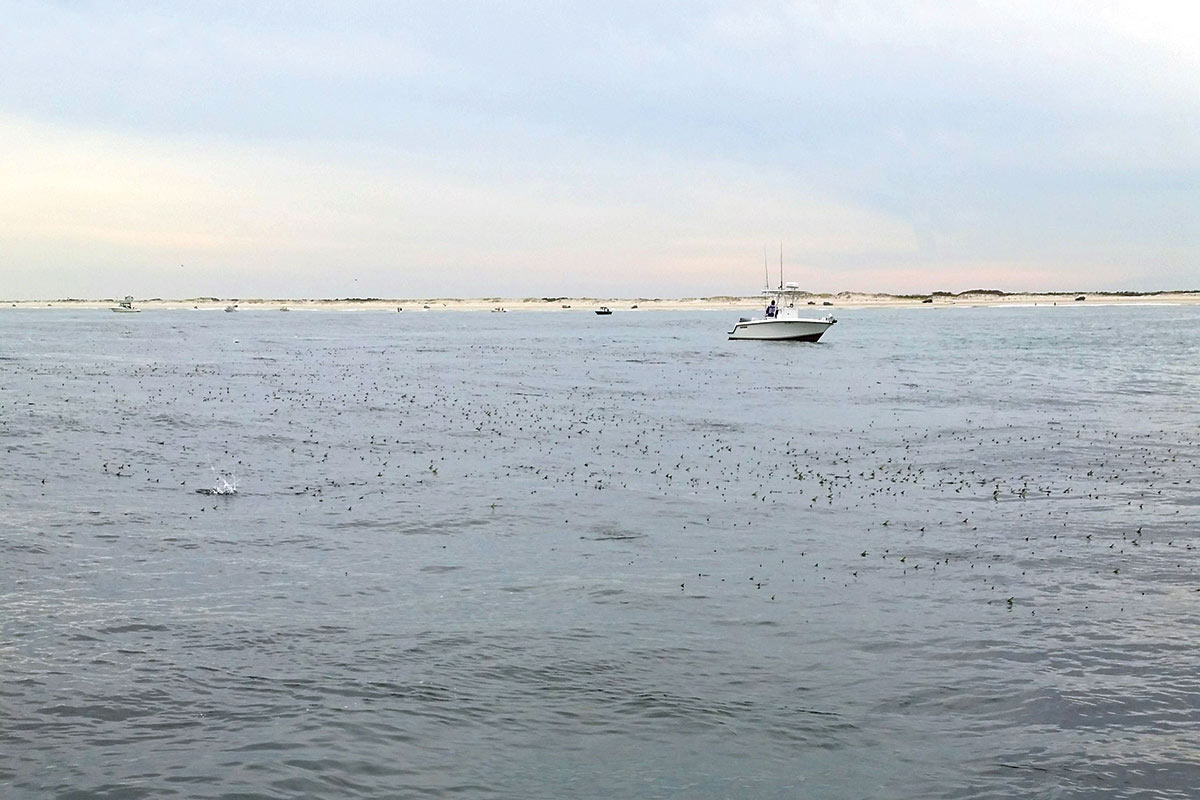
With another striped bass season close at hand, it’s time to rethink the way we go about targeting this valuable resource.
Snag n’ drop has been a popular and effective technique for scoring stripers since the early 2000s when the bunker became plentiful after the bunker boats were pushed out of inshore waters. It is very simple – an angler casts a weighted treble hook into a school of bunker and reels while whipping the rod in order to drive the hook through an unsuspecting bunker. Once a bunker is hooked, the angler puts the reel in free-spool right away and “drops” the bunker into the school.
The reason that this works so well is because once the bunker gets snagged, it emits a “panic” signal and the school moves away and isolates that single bunker. If bass are in the area, they are sure to engulf your bait very quickly. Seems like a great technique, right? It is indeed very effective, almost too effective with the stricter striped bass regulations. The 8/0 and 10/0 bunker snag hooks are great for snagging, but they could be detrimental to a bass that an angler intends on releasing.
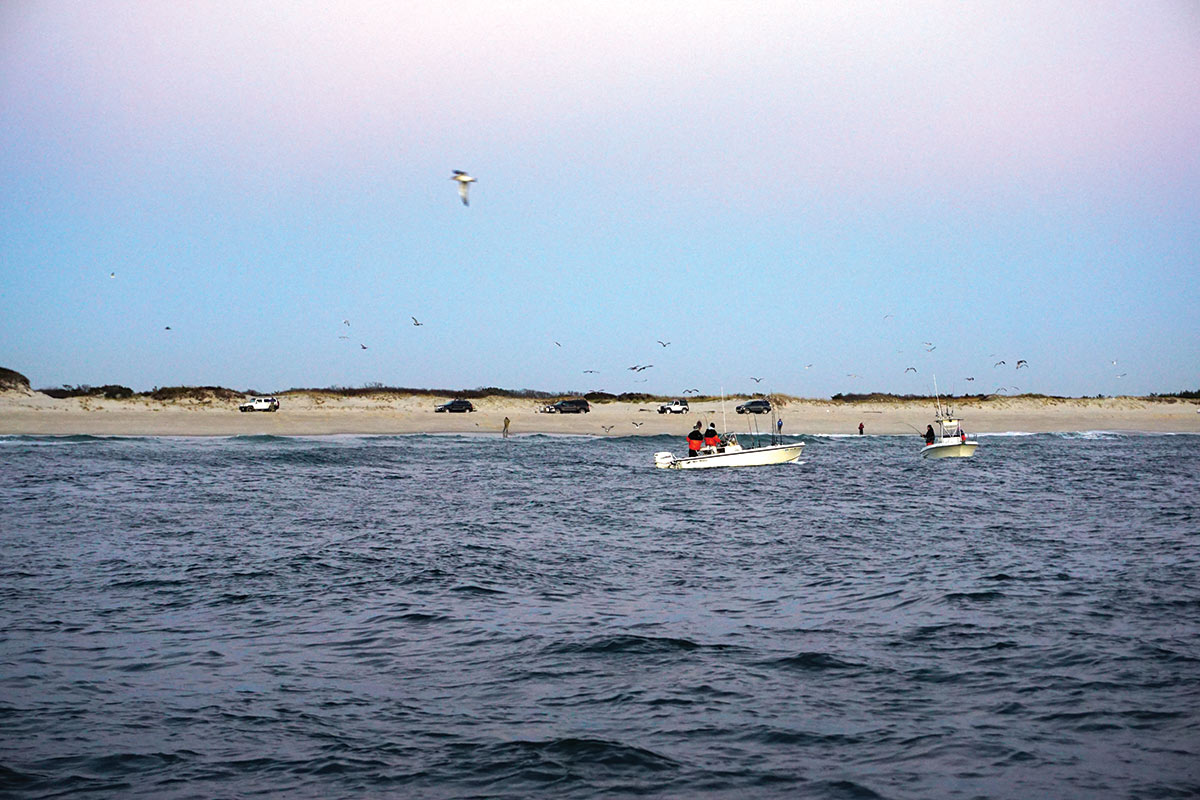
The treble hook has a great time and place, but using one for fishing live/fresh bait is not ideal. At times, the bass attack the bunker with such force, they practically inhale it. The treble hooks can be harmful, if not deadly to a fish should they get the hook caught in the stomach or gills, which is common in this type of fishing.
While the snag n’ drop technique is the standard go-to technique for a frothing school of bunker, there are other alternative ways to fish this bait that are just as effective, without causing unnecessary harm to the bass.
Live Bunker Rig
One possible alternative to simply snagging a bunker and dropping isby first filling the livewell with enough live bunker to fish with, and using an 8/0 circle hook on a fishfinder rig to fish those stored baits. Besides this being beneficial to the bass, the single hook also gives a better hookset along with an exact placement of the hook in the bunker, which is ideally in the fish’s back, near the head.
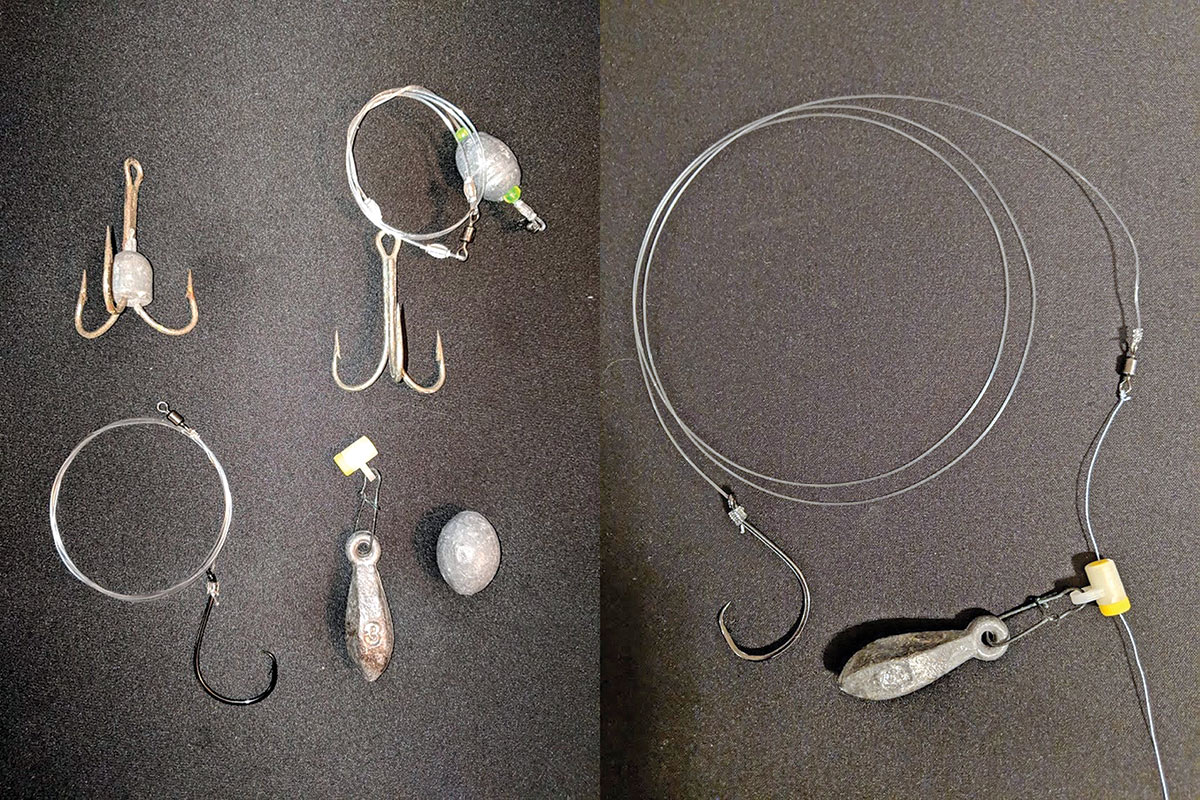
Liveline rigging for stripers is simple; tie (a snell knot is preferred) an 8/0 circle hook onto a 36-inch piece of 50-pound mono or fluorocarbon leader to a barrel swivel. Then use an egg sinker or fishfinder/sinker slide on the main line with a weight of your choice. I’ll use anywhere from a 2- to 4-ounce bank sinker, just enough to keep the bait in the school of bunker.
The hook and leader size/pound test/length can vary based on the size of the fish you’re targeting; if the bunker/bass are small-medium size, then maybe a 6/0 hook and 40-pound leader would be more fitting. Large bunker and large bass may require a 10/0 circle hook and upwards of 80-pound leader. Heavier leader in general makes it easier to leader fish and it also helps stop the bluefish from biting through.
While this is a simple rig, it is also very effective. I prefer this over snag n’ drop because I like fishing for bass with a conventional set up, but snag bunker with a spinning reel set up. One other advantage of this rig is that the bunker is not directly carrying the weight of the sinker or weighted treble and therefore, gives the bunker a longer life and allows it to swim and be more active. When the bass picks up the bunker, the only resistance it feels is the weight of the bait since it’s on a sinker slide. The bass swims away with the bait and since a circle hook is being used, just lock up the reel and the bass will hook itself.
Heads Down
Striped bass are often accompanied by bluefish during their migration along the coast. Much like bass, these toothy fish also enjoy a fresh bunker. Anyone that has ever fished for bluefish; either snapper blues or big gators, knows that they always seem to go for the tails. Whether it be fishing with spearing and a bobber off a dock, casting paddletails and soft plastics on the flats of a channel, or even using poppers and swimming plugs for them, bluefish always seem to go for the tail.
While striped bass can be aggressive at times, they are mainly opportunistic and ambush feeders. Opposite of the bluefish, bass always seem to go for the midsection or the head when they ambush/eat their prey. When using swimming plugs for bass, many anglers notice that the bass are hooked on the front or middle hooks. They conserve energy and consume as much food as possible while spending as little energy as possible. Bluefish, on the other hand, are primarily aggressive and will actively chase their food, which is why they seem to always bite the tail.
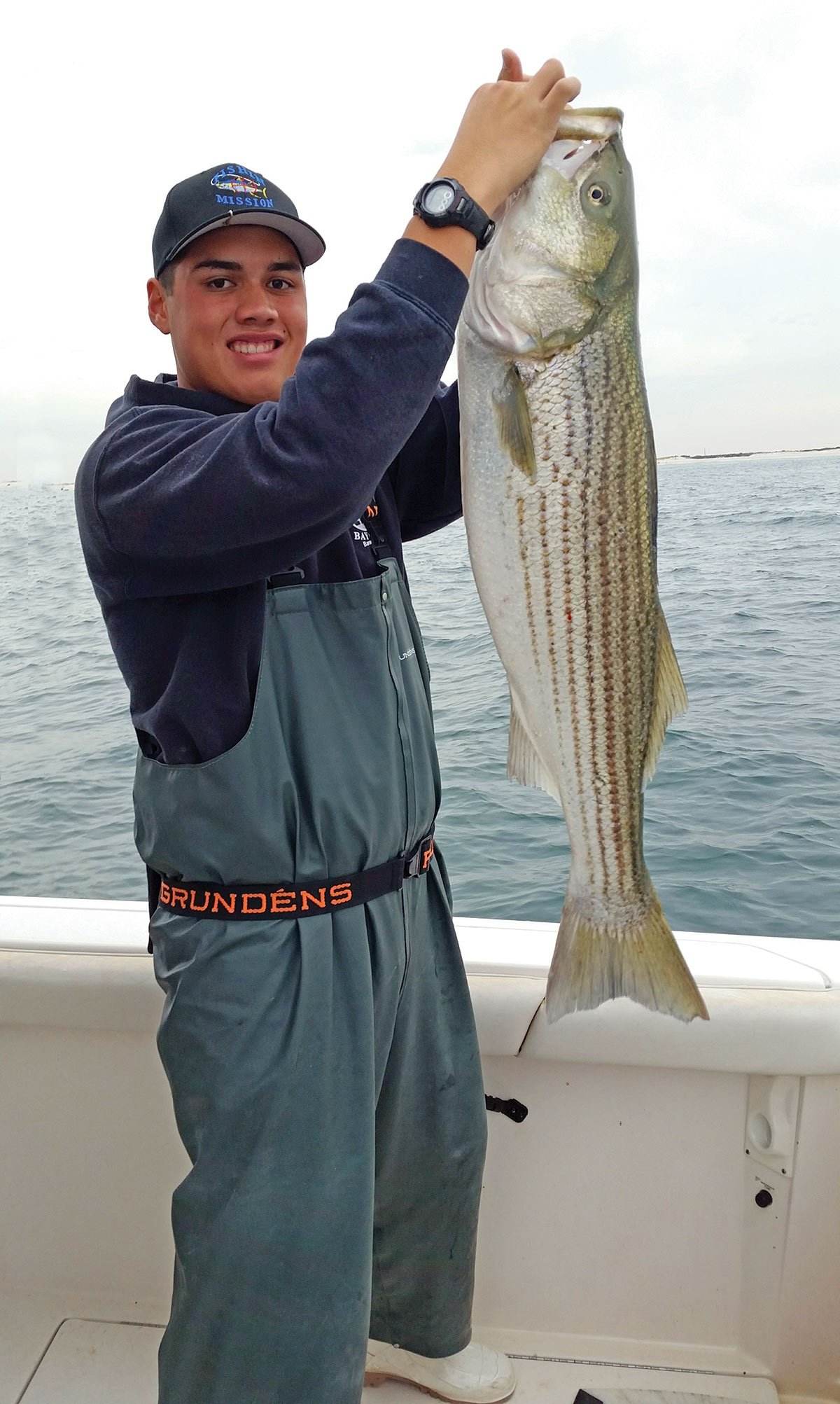
When bass and bluefish are traveling together, the bass take advantage of the bluefish’s high energy. They let the bluefish do all the work by chopping the bunker in half and disable the bunker. The bass hang out below the school of bunker and eat the freshly chopped bunker heads.
The rig for this is the basically the same as the circle hook rig used for live bunker. However, a smaller hook like a 6/0 circle and a lighter 40-pound leader can be used since bluefish tend to usually stay away from the heads. A lighter sinker can also be used since the bait isn’t really moving.
One important tip when using a head is to be sure to cut the bunker a little bit further than halfway back. Making sure the guts are attached to the head is a great idea since that contains a lot of oils and scent, which will ultimately draw in the bass. Another morbid yet effective technique for using the head is to cut a bunker in half while it is still alive. The involuntary muscle convulsions that happen after the bunker dies are very appealing to bass. It gives an even more realistic appearance of a bunker that had just been chopped in half by a bluefish.
Avoid the Crowds
Wherever there are bunker, there are usually bass, which means there are surely going to be boats. With high boat traffic, the bite can quickly go from hot to non-existent. When this happens, fill up the livewell with a dozen or two lively bunker and move to a different area. Even where there aren’t always bunker present, there could still be bass there.
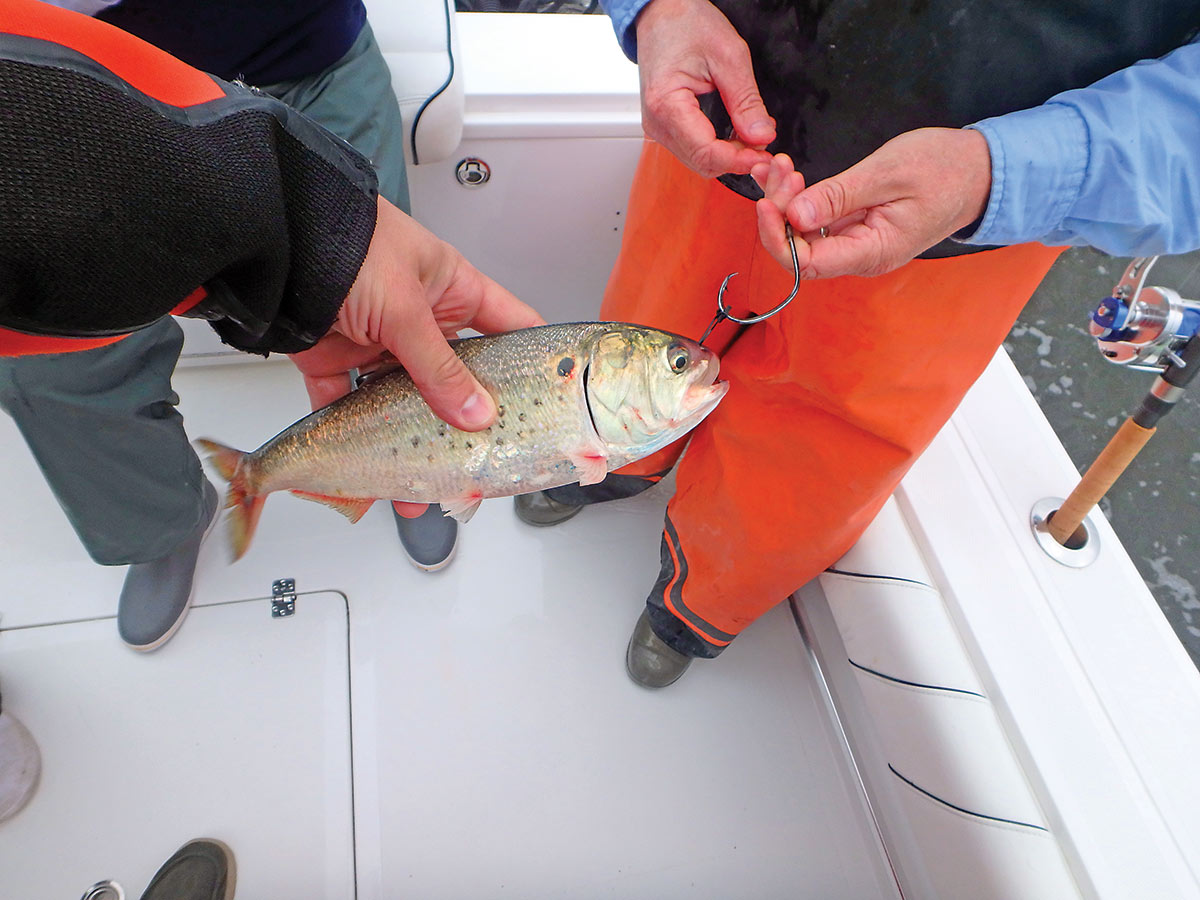
Sometimes moving to deeper water or structure and livelining bunker is a great way to find fish without the boredom of trolling. Stop on any structure like holes, wrecks, rock piles, and the like and drop a couple of bunker down. The bass will make themselves known relatively quickly if they’re there and ready to eat. Just keep in mind that when fishing deeper water with live bunker, it is usually necessary to use a heavier sinker in the 6- to 8-ounce range.
Overall, using live bunker for bait is one of the most successful types of fishing for stripers. Using circle hooks instead of trebles will not only help land more fish, but it will also help sustain the population for years to come. Keep in mind that in some states (Virginia for example) it is “illegal to snag, or attempt to snag, any fish,” while IGFA does not recognize potential record fish as being caught with the “snag and drop” method.
| A CONSERVATION FOCUS |
|---|
|
There’s absolutely a higher chance of losing a fish with the snag n’ drop technique. Because this technique entails a random hook placement in the baitfish, the hookset with a weighted-treble hook is more likely to pull as opposed to a single, purposefully-placed hook. Furthermore, the single hook alternative could be a circle hook, which drastically increases the chance of fish survival upon release. Despite its lack of efficacy, manyanglers rely solely on the snag n’ drop method is because of its ease. If they drop a fish, they simply recast and repeat the snagging process; it requires less planning, or rigging experience when compared to true livelining where success is dependent on purposeful hook placement, locational planning, and an understanding of bottom structure and fish behavior, among other factors. It’s often more effective, and always most conservation-friendly, to employ alternative methods like pencil popping or tossing large swimmers around the schools, or true livelining. Knowing when to use one of these aforementioned techniques/tools vs the others depends on one’s knowledge of recognizing pod activity and crowd hindrances. Because of these additional considerations, livelining is more of an art, and therefore is more respectful to the fishery. Although many anglers just starting out in the striped bass fishery rely solely on the snag and drop technique, they eventually move towards the alternative, conservation-friendly methods of re-rigging, or even fishing artificials. As noted, the International Game Fish Association (IGFA) will disqualify any potential record catch if involved “intentionally foul hooking or snagging a fish” or when using “double or treble hooks” when baitfishing. – Dr. Adam Aguiar (Stockton University Ecology/Saltwater Fishing Professor) |



